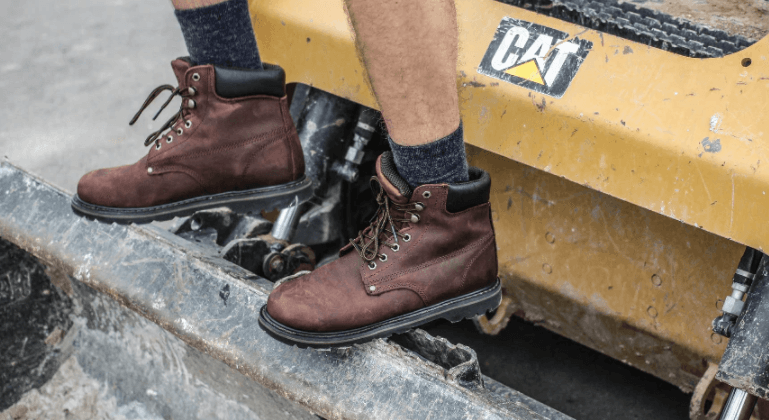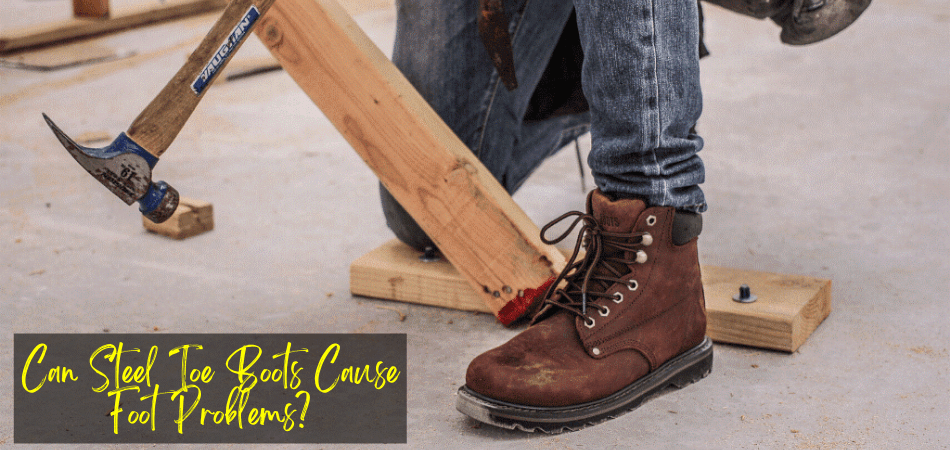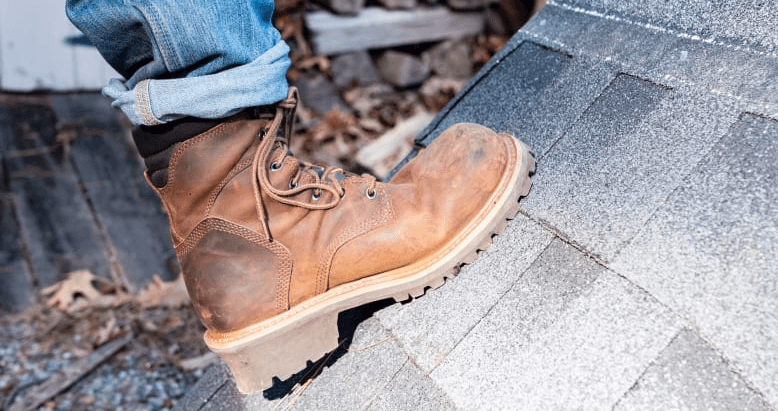Steel toe boots are great for workshop use as they’ll help to prevent unpleasant workshop accidents. A heavy piece of metal can accidentally fall off the workbench onto your feet. In such an instance, you’d be grateful you had good boots on.
But no withstanding all the good it does, steel boots can also be too heavy for you. This is because most steel toe boots are usually heavy with additional materials to shield your toes from external dangers. So, can steel toe boots cause foot problems? Steel toe boots can cause foot problems. However, you can avoid this if you know some things to do.
Read along to learn how you can use those boots without the usual sores or blisters.
Contents
Why Do People Wear Steel Toe Boots?
Many people wear steel toe boots for many reasons. Some to avoid work-related accidents, while others might be for fashion considerations. Whatever your reasons are, let’s consider the main reasons behind the design and production of steel toe boots.

Protection from free-falling objects
Most organizations make boots mandatory for staff members carrying out operations in workshops. Workshops are common places where heavy objects are handled, which can easily fall. The chances are that you’ll eventually have an object falling onto your toes.
Thankfully, many steel toe boots can take as much as 75 pounds of impact from falling objects from as high as 3 yards. You can’t tell if that heavy object you’re moving or lifting will land on your toes; that’s why the steel boot is there to protect your feet.
The treads of steel toe boots are highly resistant to slips
You can easily slip and fall in a slippery area if the treads of your shoes are too smooth. Steel toe boots have good traction that will immensely reduce your chances of slipping. Slips and falls are the most common causes of workshop accidents and can be avoided if you have your steel-toe boots on.
Improved posture and reduced risk of muscle strain
Apart from the dangers of having your toes crushed by a falling object, steel toe boots will protect you a great deal from muscle strain. These boots are properly cushioned and provide enough arch support. The support of your foot, arch, and ankle by your steel tip boots help to align your legs. This further improves your posture and reduces back pain.
Steel toe boots can help protect you from electrocution
Electrocution can pose a major health risk for workers in factories or workshops. Apart from other protective clothing and measures, it’s important to wear protective footwear. The recommended shoes to be worn in electrical workshops should be made from a highly insulative material.
Some steel toe boots are rated for protection from electric hazards. Having them on will help to reduce the risk of electrocution and the build-up of static electricity. We highly recommend these rated boots if you’re working in an environment with standing water.
Protection from unfavorable weather conditions
Steel toe boots also do a good job of protecting you from harsh environmental conditions. When you’re working in extremely cold locations, wearing a pair of steel toe boots will help to protect your feet from the elements. Some steel toe boots that are waterproof will help to keep your feet dry on rainy days.
Protection cuts and lacerations
Your workshop probably has tiny pieces of metal or tag nails scattered across. A carpentry workshop is common for nails protruding from woods or strewn carelessly around piercing through thin-soled shoes. Steel toe boots have thick soles that can give your feet sufficient protection from such lacerations and cuts.
Can Steel Toe Boots Cause Foot Problems?
Steel toe boots won’t necessarily cause foot problems; they were meant to protect your feet, after all. They only pose issues when you’re wearing the wrong size of boots, or you’ve worn them for too long in a stretch. An oversized boot can be a thing to be worried about and a tightly-fitted boot.

That is why you must go for steel toe boots that are just the perfect size for your feet. They’ll provide you with all the protection your feet need from common workshop accidents. In addition to this, boots that are the right size feel more comfortable, allowing you to enjoy the benefits of those workshop boots to the maximum.
Apart from the common blisters and soreness workers complain of due to their steel toe boots, other issues can result from your steel toe boots. The boot itself can cause them, and on the other hand, you can cause yourself problems too. Below are some issues steel toe boots can land you into.
Foot Problems From Steel Toe Boots

Blisters
Blisters are not just restricted to steel toe boots; even your everyday office brogues or Chelsea can earn you some. This condition usually results when your shoe is too tight on you. This is a minor issue that might not be a thing to worry about. However, it can result in worse issues when you neglect them.
Here’s how your steel toe boots or any other shoe give you blisters: The skin of your feet rubs on the insides of your boot. The rubbing in the toe or heel area after excessive repetition results in a little cut under the skin’s surface. When that happens, blisters will be the result.
Hammertoe
This condition usually results from wearing a steel boot that is too short or tight. Just in case you’re wondering, hammertoe is a condition that makes your toe curl downward, making the joint protrude upward. This can be very uncomfortable but can be treated.
The tight-fitting steel at the tip of the steel toe boot will force your toes to bend in order to fit in. This commonly happens to the third or fourth toe.
Calluses
Calluses are excessive skin build-up on the sole of your feet. Calluses usually result from wearing very tight footwear and exert excessive pressure on your skin. You’ll commonly find calluses under your toes.
Bunions
Steel toe boots can also easily cause bunions. This usually happens when you’re wearing steel-toe boots with narrow tips with wide flat feet. The narrow tip of the boots ends up squeezing your toes tightly together. The funny-looking bump that appears in the bony part of your toes is what is referred to as a bunion.
Bunions don’t look like a threat when they start developing as they develop slowly and are sometimes painless. These seemingly harmless bunions can later result in severe pain caused by irritation from your steel toe boots.
Plantar Fasciitis
You’ve probably heard of Plantar Fasciitis before. Just in case you have no idea what it means, it refers to the pain you feel on your heels after wearing your steel-toe boots for a long time.
This strain injury results from standing for too long while your steel toe boots are on. Also, it may result from wearing steel-toe boots with inadequate support for your foot arch.
Crossover toe
This is a common condition that results from wearing steel toe boots (or other shoes) with a narrow tip. The tight tip of the boots has to force your toes into a very narrow space, resulting in the crossing over. A crossover toe describes a condition in which your second toe crosses over the big toe. Thus, the term ‘crossover.’
Metatarsalgia
This problem usually results from frequently moving around while your steel toe boots are on. Metatarsalgia is a foot problem where the ball of any of your feet gets inflamed. This can happen whether you’re wearing tight boots or not. Despite being considered an unserious issue, metatarsalgia can be disturbing since you might feel some pains.
Tips to Prevent Foot Problems From Steel Toe Boots
You can put in place measures to reduce or eliminate the chances of your encountering some of the conditions above.

Put on thick socks
Socks will help to provide a layer between your skin and the leather of your steel toe’s interior. Thus, reducing the risk of blisters that result from continuous rubbing. Socks also help reduce the pressure exerted on your feet by the boots.
Try using additional pads
Pads help to keep your feet protected, especially if the insides of your shoe feel sharp. Adhesive tongue pads will help you get the job done. Slice them up into strips and insert them into the tip of your shoe.
Lace steel toe boots feel more comfortable
As awkward as this tip sounds, it’s worth it if you want to get maximum comfort while wearing any shoe. Laces help to make your shoe adjustable. If your boots are oversized, your feet will constantly move about inside the shoes, resulting in problems. Shoelaces will help to keep this at bay.
Don’t wear boots with narrow tips if you have wide feet
Boots with narrow tips usually cause some of the problems listed above. Some of the problems include bunions and crossover toe. Make sure your toes don’t feel squeezed or constricted inside those boots.
Your boots need arch support
Your boots’ lack of arch support is probably the reason you’re having that uncomfortable feeling when you have them on. The balls of your feet should be at the boots’ widest part – this provides the best fit. You can insert insoles to make up for boots with inadequate arch support.
Frequently Asked Questions
Is Wearing Steel Toe Boots All Day Bad For Your Feet?
Wearing steel toe boots all day isn’t bad if you’re wearing the right size of boots with adequate comfort. We recommend that you have some good insoles and socks on. They’ll help to reduce the discomfort felt when wearing these boots. Also, your shoe doesn’t necessarily have to be tight to give you discomfort – an oversized boot can cause problems too.
Conclusion
Can steel toe boots cause foot problems? Steel toe boots can be a source of discomfort or issues if they’re not the right size or lack adequate arch support. The shape of your boots’ tip can also contribute to the problems you’ll encounter with steel toe boots.
We have also mentioned some tips that will help reduce the problems you encounter with steel toe boots. Overall, your safety comes first – and your safety steel toe boots contribute to it. So, make sure you get a comfortable pair of boots for your workshop.

